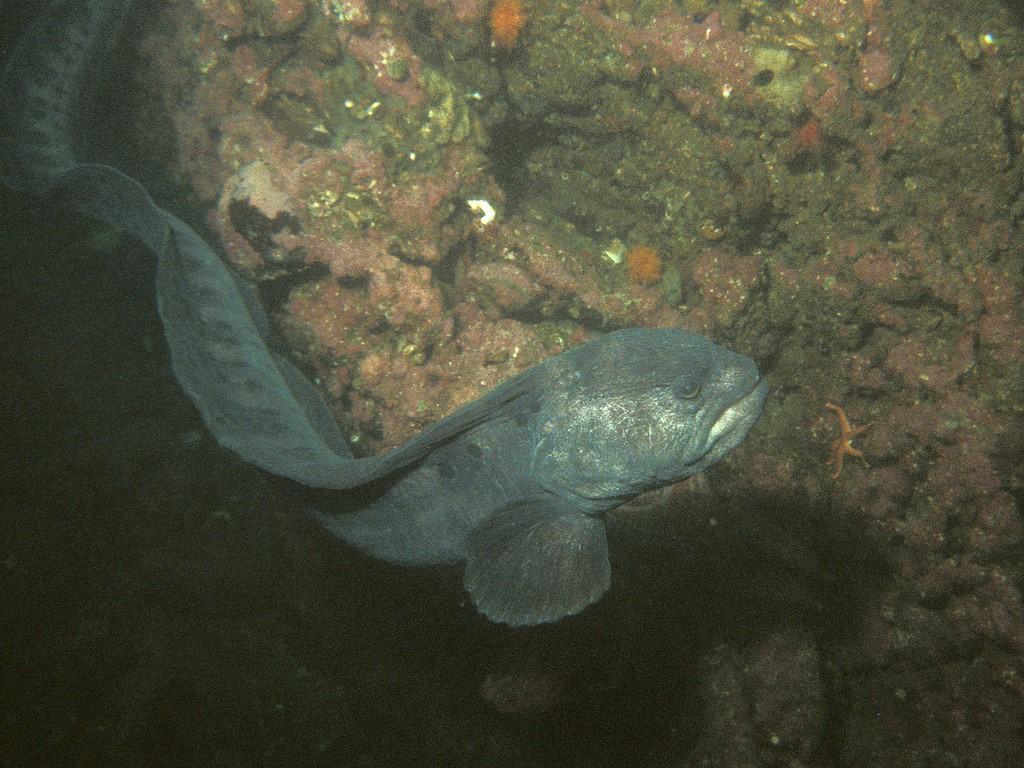

#Wolf eel head skin
Do not have scales like most other fish –their scales are very small and imbedded in their skin giving them a leathery feel and appearance.Sometimes get “itchy” skin and can be seen swimming upside down rubbing their backs on rocks to scratch the itch.Have a thick slime coating on their skin that helps protect them (works like an immune system).Can live more than 20 years in an aquarium setting.These spots allow biologists to individually identify our different wolf eels at the aquarium. Each individual has a unique pattern of dark spots on its head and body.Octopus and wolf eels often compete for den space.Only one parent at a time will go out to feed. They are guarded by both parents who wrap themselves around the egg mass for protection. Female lays about 10,000 eggs in the den, which take between 13-16 weeks to mature and hatch.Inhabit dens, crevices and caves in the reefs.Both males and females have a dorsal fin that stretches from head to the end. Gentle, slow-moving creatures and are often very friendly with divers Wolf-eels live in rocky reef-type habitats from the intertidal zone down to.Females keep the younger looking more streamlined face and are typically a bit darker in color. Males are a lighter grey color and have a fat wrinkly face when reproductively mature – around five years old.Can grow up to eight feet long and have 200 spinal vertebrae.
#Wolf eel head cracker
Jaws are powerful and equipped with 3 rows of molars across the roof of their mouth and 2 rows of molars on the bottom jaw – used like a nut cracker to crush hard foods like urchins, clams and crabs As wolf eels age, the bright colors dull and they become shades of grays and browns.Young are brick red with bright orange and purple highlights.Not a real eel, just a long skinny fish.Wolf eels are not the same as true eels because they have pectoral fins behind their head, which is a characteristic of a fish, which is not in the eel family (almost all true eels do not have pectoral fins). Only a few deep water species of true eels can be found in Washington waters and none are likely to be seen in Puget Sound. The wolf eel is in the family Anarchichadidae (wolf fishes). Here are some fun and interesting facts about wolf eels. Today the featured animal is the wolf eel. He has produced over 70 scientific and technical publications, is an avid SCUBA diver and loves Wolf Eels.Join us for hands-on activities, special talks and opportunities to learn more about the care and feeding of the Aquarium's fish, birds, tide pool animals and marine mammals during Winter Fishtival! Each day we'll highlight a different sea animal and activity. Mariliave has worked at the Vancouver Aquarium, where he is a research scientist, for more than 25 years. Adults wind those long bodies into caves and crevices, sticking out just their heads as they wait for dinner. Once you get past their strange face and head, the body of the Wolf Eel just keeps on going in thick muscular waves of tail that can stretch nearly 8 feet behind them.
#Wolf eel head full
Named for their mouth full of sharp teeth and powerful jaws, Wolf Eels are able to crush large crabs, urchins and shellfish with a single bit.

With a face only a mother could love Wolf Eels have large heads, the jowls of a wild boar and a bulging forehead. Jeff Marliave of the Vancouver Aquarium speak at Camp Orkila on Tuesday, Nov. Have you ever wondered if the Wolf Eel is really an eel or just a fish disguised as an eel? Or maybe even monster relic of the dinosaur era? Come hear Dr.


 0 kommentar(er)
0 kommentar(er)
